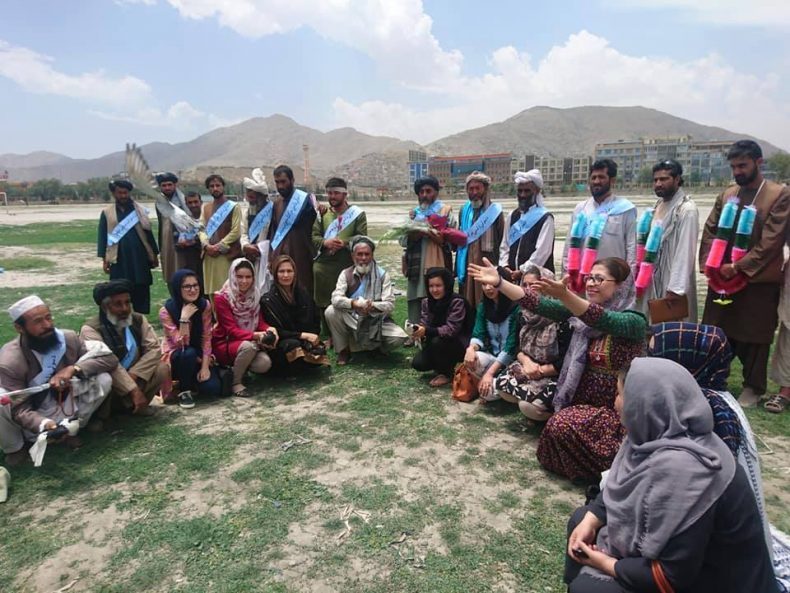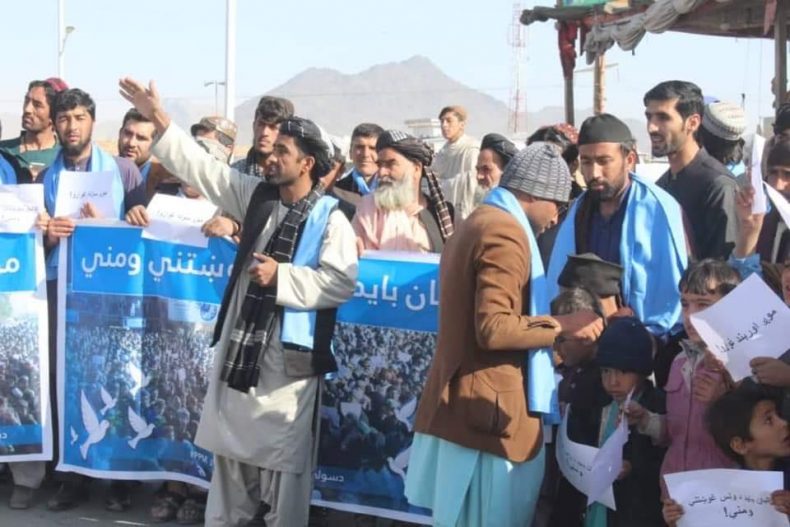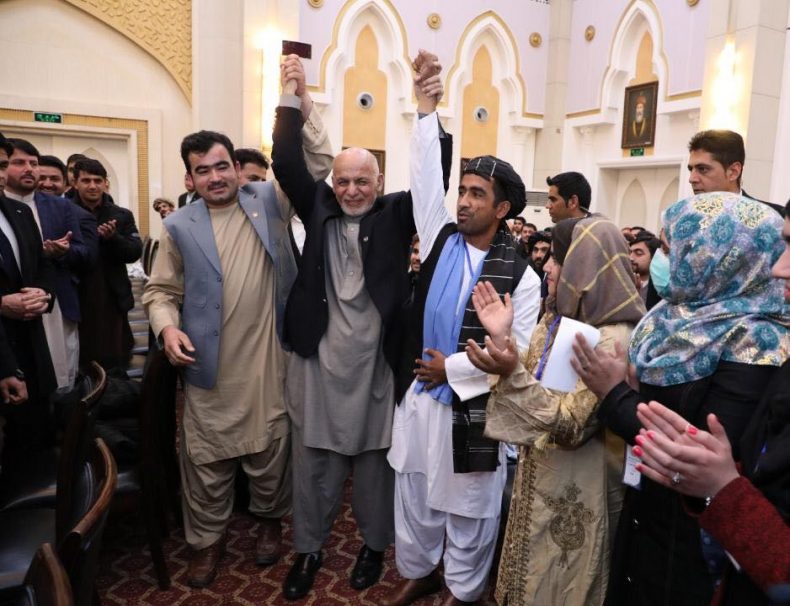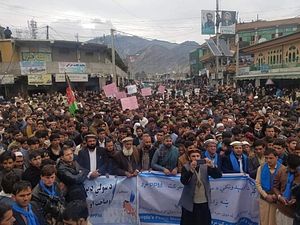The recent peace process has been a strange time for Afghans. In October 2018, the U.S. government met secretly with the Taliban, excluding the Afghan government. Then, days later, General Abdul Raziq was assassinated in Kandahar by insurgents at a high-level meeting with a U.S. general, who was unharmed, leading to a wave of distrust and speculation that the United States knew the attack was planned.
In December, it was reported that Trump intended to withdraw half of the U.S. troops in Afghanistan in 2019. In the last week of January, the United States sent Afghan-American Zalmay Khalilzad as an envoy for peace to negotiate with the Taliban in a six-day meeting in Qatar. The U.S. embassy in Kabul has allegedly started plans for its own drawdown.
“I think the U.S. will have their presidential election and wants to finish this war and feel they cannot finish it by military force, but only by peace with the Taliban,” says 27-year-old Mohammad, who comes from a Hazara community in insecure Maidan Wardak.
I met Mohammad, who is using his first name only to protect his family’s identity, in October 2016 while trying to cover a series of Islamic State attacks during the holy Ashura gathering that killed 16 people in Kabul. He had gone to a shrine, despite the threats.
The following year he spoke about death threats from the Taliban against his three sisters, who worked as police officers. The sisters, aged between 25 and 28, had been trained in Turkey in 2015 and 2017 under an initiative designed to promote women in the security sector, supported by NATO countries. Three threat letters were sent to his father, the first referring to the first sister to train in the force. Eventually, the letter writer mentioned all three sisters.
“The last letter said they would behead our family for working with the infidels,” Mohammad said by phone.
In the summer of 2017, the Taliban had killed two women police officers, also sisters, who had been in the same class with one of his sisters. By May 2018, the youngest sister, Mohadisa, had fled to Turkey to claim asylum with UNHCR. The other two are still working as police.
For people like Mohammad and his sisters, the peace talks feel unsafe.
“Yes, we want peace but not at the cost of our lives. Not at the cost of our freedom,” said Samira Hamidi, a prominent Afghan women’s rights defender who has worked for a number of national and international organizations.
The situation is critical for women in the trenches, like Mohammad’s sisters and rights defenders like Hamidi. “When the U.S. came in 2001, we [women] were broken from the war, but we are not victims anymore,” she said. “Now, we are leaders. We can represent ourselves in the peace process and we should be part of it.”
The Taliban counter that women like Hamidi and the three sisters are not traditional Afghan women.
Forozan Rasooli, a female civil society activist who traveled to the Geneva conference in November 2018 to represent their voice, is aware of this: “The Taliban say outspoken women do not represent the majority of women.”
To address this, Rasooli explains, First Lady Rahula Ghani launched the National Consensus in August 2018 to consult with women in the provinces about the peace process. In Baghlan province in September, about 400 women came. Later, in December, 500 women in Kunduz and Herat provinces participated.
“I think it’s a good initiative, but if it could go faster and the data could be shared, it would be better,” she said.
The point is, Rasooli underscores, is there is a peace process already.
“It’s working, it just takes time.”

Forozan Rasooli, deputy director of EPD, meets the Helmand Peace Marchers with women activists. Photo courtesy of Equality for Peace and Democracy NGO, June 2018
The Tipping Point
Last March, a grassroots peace movement that came be known as the Helmand Peace March, or the People’s Peace Movement (PPM), began a sit-in protest in response to a suicide attack in Helmand. They met with the Taliban to try to stop the attacks. This peaceful protest included women as well. At the direction of the insurgents, they were told to take up the issue with the foreigners in Kandarhar, so the men began walking. The women stayed.
As Helmand is considered mostly Taliban-controlled, the marchers were accused of being aligned with them given their apparent ease in traveling through the territory. They ended up going all the way on foot to Kabul.
Ahmadzai Yasar, a peace expert from the Afghanistan Institute of Peace, a national think tank, says that only those who stand to lose from peace promote that perspective.
“There were a lot of people that joined this movement to share this voice. This can be a good way to do advocacy for their rights. As a peace builder, I appreciate this,” said Ahmadzai.
Social media helped to spread their story under hashtags, eventually garnering about 40,000 followers.
Wali Bawar, who was attending university in Kabul, traveled by bus to meet the peace marchers in Zabul and Ghazni provinces last June. He, like many others, helped promote their cause on social media.
“I only walked a few kilometers with them, but I got to know them and like them. Now, they are really my close friends,” Bawar said. “But first, I went there for the peace situation.”
Why travel such a long way, along a dangerous road in Taliban territory? “Because it’s everyone’s responsibility to support them,” according to Bawar. “First [we do this] for our ideas, and also, I spent a lot of time with them and they are really friendly and honest for their country.”
As their journey spread, so did their message and their membership. Monawar Wahidi met the group when they came to Kandahar. He didn’t join the peace walk but he supported them as an organizer. He uses his Facebook page, which has 18,000 followers, to promote the group’s activities and message – which is often simply: “we want peace.” He says the group, the People’s Peace Movement, or the PPM, can now be found in every province. He leads the Kandahar chapter.
The peace marchers are predominantly men. Peace expert Ahmadzai explained while women cannot join marches due to safety concerns, they supported the movement by visiting the marchers in parks.
Rasooli and a network of women from several provinces went to welcome the marchers at a park in Kabul, where they gave them flowers.
After arriving in Kabul, the peace marchers staged sit-ins in front of a number of embassies, including the United States’, where they sent a letter to the U.S. Congress calling on the superpower to end the war. Wahidi believes the peace marchers pushed Washington start talks with the Taliban.
“Why not?” he said. “This started after our movement started. The ceasefire started as our group arrived in Kabul.”

Monawar Wahidi, member of the Kandahar People’s Peace Movement (center left, with arm raised), speaks at a PPM gathering. Photo courtesy of Monawar Wahidi and PPM.
Technology Divide
Just as some suspect the marchers are aligned with the Taliban, the insurgents have also accused them of being led by foreigners. But Wahidi said the group is volunteer-led. “If we work for an NGO, they will give us a special responsibility, rules, and regulation. Nobody is paying us money. We are not a project.” They promote their work on social media.
The Taliban have been known to restrict media, including social media, in Taliban-controlled territories. Comparisons have similarly been made between urban government-held territory and the countryside, the supposed technology haves and the have nots. But analysts have mentioned this division exists within the Taliban as well.
Michael Semple, who was famously deported from Afghanistan in 2007 for unauthorized talks with the Taliban during the peace efforts of those days, wrote that this division can be seen on Taliban WhatsApp communications channels. Those messages show gaps between the hope that young fighters express about the end to the war, compared to the measured response of the leaders. He wrote the Taliban were “predominantly millennials and many carry phones and post on Facebook.”
Similarly, an AFP report described an “army of interns” marketing “propaganda on Taliban WhatsApp messaging channels, according to some analysts. In 2016, the group launched its own news app, which was swiftly taken down by Afghan government authorities. Apps are used in recruiting and planning attacks, leading to a temporary ban on WhatsApp in 2017. Vice also reported on the Taliban’s use of apps to solicit funding.
Under the Taliban, messaging apps are used as a means of control, not communication, according to analysts.

Monawar Wahidi of the Kandahar PPM meets with President Ashraf Ghani (center) in February 2019. Photo courtesy of Monawar Wahidi and PPM.
Grassroots Inclusion
International media coverage has quieted since the marchers began their journey, but local media still covers their work. Last week, the PPM staged a large protest in Kunar province. Wahidi traveled from Kandahar to Kabul last week to attend a conference at the presidential palace about the peace talks “and many things.”
Wahidi says “we want peace first before the withdrawal of troops.” He also believes the peace talks should involve the Afghan government, which he says was legitimately elected.
For others, like Mohammad and his police officer sisters, the issue is potentially life threatening. His sister, whose asylum claim in Turkey wasn’t supported, is now in Austria.
“She says the U.N. was not helping her,” Mohammad explained. Thousands of Afghans have been deported from European countries.
The rest of the family moved to Kabul. “We are compelled to live in Afghanistan and yet, we can’t go back to our district. If they [Taliban] enter Kabul, I’m absolutely sure they will find us.”
He believes that former jihadi leaders, who were selected to speak on behalf of Afghanistan in Moscow, need to first find peace among themselves before negotiating with the Taliban.
Commenting on the lack of women in the process, Hamidi is more direct. “We don’t want any man, including the Taliban or the U.S. government to fight for our rights — we want to do it ourselves. We know what our country is going through — it’s a joke that someone sitting in a palace or the U.S. knows what’s best for us.”
Local media reported that 40 Afghan women tried to join the peace talks in Qatar that began on February 25, but their visas were not processed in time. The Afghan Women’s Network (AWN), who were referred to in the report, have issued no statement about the visa issue. However, AWN posted a press release on the Doha talks requesting trust building from the insurgents:
News of forced displacement, infliction of indiscriminate violence on civilians, stoning of men and women without regard for the Islamic principal of justice, closing of schools — 1200 in the last count — and erasure of women from public life are some of the most common experiences that come out of Taliban controlled areas.
As official talks progress, the Taliban don’t seem to be factoring in women and grassroot voices. Whether the United States listens or not remains to be seen.
Michelle Tolson is a freelance journalist based in Asia.

































